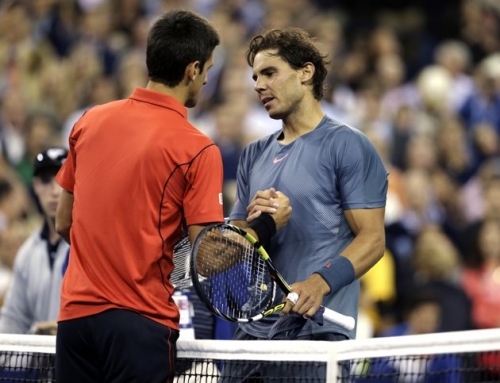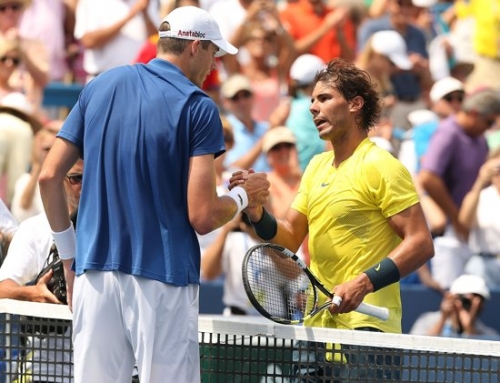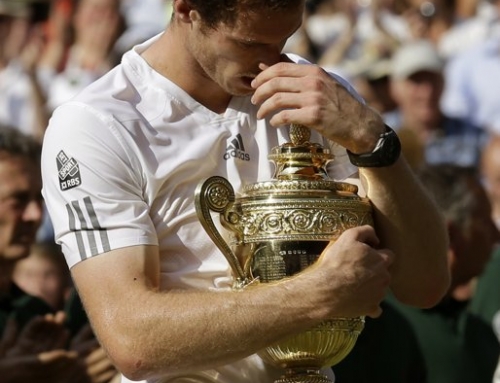Even if Roger Federer thinks otherwise, Federer’s game is currently behind Djokovic and Nadal. With Djokovic’s loss, the big question is whether his mental toughness that kept him on this streak will last the rest of the year. Historically, the answer is yes. When McEnroe lost to Lendl in the 1984 French Open, he continued to play well the rest of the year. When Vilas lost to Nastase, a controversial loss, Vilas continued to win throughout the year. This suggests that Djokovic will still continue to win.
Before I review the French Open final again (I find that the initial review tends to be more stream of consciousness, which can lead to a meh review), let’s quickly check the rankings.
First, Djokovic is now within a hair’s breath of taking over number 1. He is less than 50 points from taking over Nadal’s spot. This will be a challenge, however. Although Djokovic lost last year in the quarterfinals and made it to the semifinals this year, thus gaining points while Nadal, who was defending champ, stayed put, Djokovic made it to the semifinals of Wimbledon last year and will need to reach the final or have Nadal lose early for him to get to number 1.
Nadal could gain a little ground on Djokovic. Nadal lost early in Queen’s Club (in the quarterfinals). Djokovic also lost early, but isn’t playing Queen’s. However, since only 18 tournaments count to rankings, and since Queen’s is a bad result, it isn’t factored into Djokovic’s rank. Nadal might gain 100 or so points by moving further at Queen’s this year compared to last.
The gap between Murray and Soderling widened because Murray made the semis this year (lost in the fourth round last year) and Soderling lost in the quarterfinals (reached the finals).
For all the lament of no Americans (men or women) in the top ten when Serena finally dropped out of the top ten due to inactivity, there are now two Americans in the top ten, mostly due to Jurgen Melzer losing a lot earlier than he did last year when he reached the semis. Fish and Roddick are now both in the top ten. Fish does have some points to defend at Queen’s however, where was a finalist. Last year, most of the top seeds lost early including Djokovic, Murray, and Nadal. This lead to a final of Querrey and Fish, neither of whom are likely to reach the final again.
OK, back to the final.
Although Federer did break the Djokovic streak, many have pointed out that Djokovic lost focus and this caused him to lose rather than Federer to win. To be fair, Federer was playing very well in the semifinals. He served well, moved well, kept in the rallies well. That’s partly because Djokovic’s style is more comfortable for Federer. Djokovic does not loop high balls to the Federer backhand. Indeed, no one does. That’s because Nadal continues to play a singular style of tennis which permits him to hit high ball after high ball to the Federer backhand. Federer can only defend on that side, and not attack. Nadal is too good on defense to allow Federer, even on a lucky shot, to win points.
Djokovic, by contrast, can take those high shots and continue to maneuver the ball around the court and then strike when needed. It’s one of the biggest differences between his game and Roger’s. The other huge difference is Djokovic’s return. Just count how often Roger netted his backhand or hit it wide on Nadal’s serve. Few players force a returner to have to go for more than Nadal. In effect, even though Nadal’s serve is not among the top serves in the game, he is very effective because he can begin to attack off the ground with a weak return. Few players take Federer’s strategy which is to attack the return even if it means more errors.
Federer had his chances in the first set. Federer was not only striking the ball well, but luckily for him, Nadal was not hitting the ball well. To put this in perspective, Nadal had 27 unforced errors in four sets. 10 of those came in the first set, or more than 1/3. Nadal had maybe 6 errors per set in the remaining 3 sets.
Federer’s game against Nadal relies on taking advantage of such miscues. Nadal pressures Federer so much and Federer takes such big risks himself that it’s only a matter of time before Federer makes an error or goes for a winner. Nadal can be much more patient because he plays defense so well. Federer is used to his hard shots giving him an opening within 4 or 5 shots. Nadal can make this difficult on Federer by aiming to his backhand.
When the drop shot at 5-2, set point, dropped just a hair wide, Nadal began clamping down on his game, and Federer’s serve, which had been rock solid, fell apart. Federer really relies on his serve to keep the game even against Nadal. He had a few games where he was able to get on top of the point, but there were just as many times where he would hit a hard crosscourt backhand only to see Nadal fetch it again. Nadal’s defense came into play many times, especially when Federer would attack. Nadal would hit a high lob that would, time and again, land in.
This is where both Nadal and Djokovic are really deadly. They can aim very close to the lines and make it in most of the times. Federer has always had problems keeping the ball in which is why he has an inordinate amount of errors.
Nadal was also able to find more spots on court that Federer couldn’t reach (often just barely out of reach) then Federer was able to force Nadal. Nadal’s winners are often balls that are barely reached or just out of reach, or occasionally a whip up the line shot, while Federer’s winners generally come with plenty of room to spare.
Still, Federer did pretty well despite this. He was down a break in the second set, but managed to get it to a tiebreak. He even got the third set. Despite the enthusiasm, Nadal played more aggressive, and the errors kept coming and coming. Nadal isn’t number one for nothing. He fights off break points like no one else. Federer had chances to win the first game of the fourth set. When Nadal held and put Federer in a similar break position, it was over for Federer. A second break ensured Nadal would have his sixth title.
The key now for Wimbledon is where Federer falls in the draw. Federer might prefer to be on Nadal’s side of the draw. Djokovic’s weakest surface seems to be grass. It’s the event he’s lost the earliest (one against Safin and once against Tommy Haas). But he’s also reached semis twice which means he knows how to play on grass. I think another person that has to worry some is Andy Murray. He’s managed to make the semis of Wimbledon twice and Wimbledon, oddly enough, seems to be his most consistent Slam.
Murray had a pretty nice draw. He faced two Frenchmen that were trying to get their games in shape, Gilles Simon and Jo-Wilfried Tsonga. The year before Wawrinka gave him problems and he lost in four to Roddick. In 2008, he lost to Rafa in the quarterfinals. Murray is generally only vulnerable to a handful of players, but he, more than any top 4 player, can have really bad days and just lose to someone unexpected. In general, this doesn’t happen in Slams. He generally loses to players that are pretty good. Even so, his ankle issue isn’t going to heal at Wimbledon and he might play Queen’s.
The one plus for Murray is that he won’t have to play Federer, at least, not before the final. The one wildcard out there for anyone is Juan Martin del Potro. Grass isn’t his best surface either, but he might still make some noise.
There’s two weeks of grass play before the big W making this the quickest transition in men’s tennis. It will be interesting to see how the top 4 fare. I think the biggest question mark is Djokovic who was on a tear up to this point. Can he rebound? How will Federer fare? Can Murray finally break through?
We shall see!




![[US Open Men’s Final] Can Djokovic beat Nadal in the finals?](https://www.essentialtennis.com/wp-content/uploads/2013/09/20130909djokovic-500x383.jpg)


![[French Open] The tactics of the Djokovic-Nadal semifinals](https://www.essentialtennis.com/wp-content/uploads/2013/06/20130607nole-500x383.jpg)